Looking for a strategic plan example for your nonprofit? You’ve come to the right place.
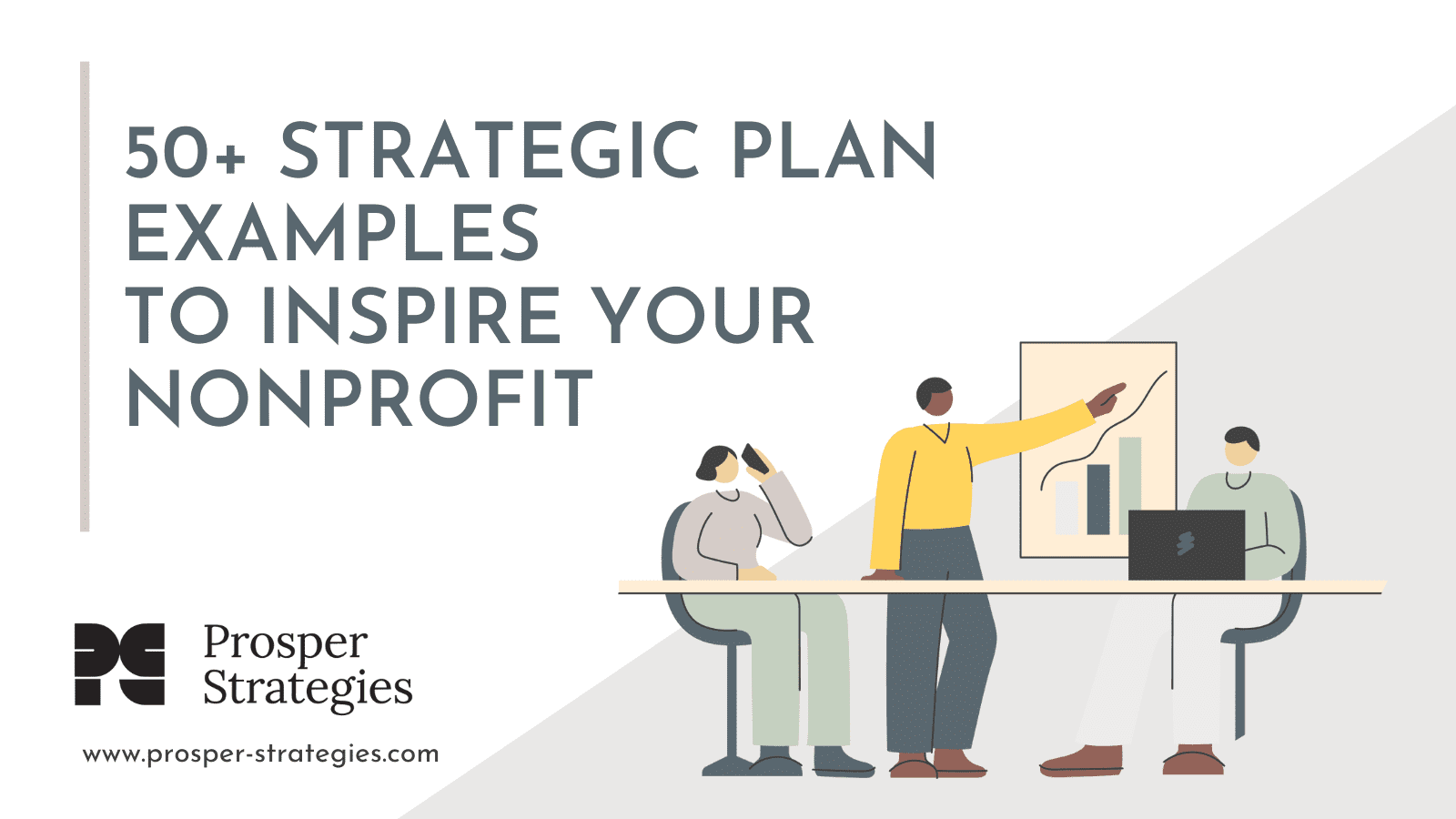
This guide curates 50+ real nonprofit strategic plans and shows how to build your own with Prosper’s Essential Nonprofit Strategic Plan Template. It explains what nonprofit strategic planning is, why it matters, and 7 best practices—especially involving stakeholders throughout—to help you create a focused, 3–5-year plan. It also links to related templates and resources to finalize your mission, vision, values, priorities, and Objectives and Key Results (OKRs).
At a glance, this post includes:
- What a nonprofit strategic plan includes (mission, pillars, objectives, OKRs)
- How to choose strategic priorities and timelines (3–5 years)
- Real examples from health, education, arts, international aid nonprofits and more
- Best practices for involving boards, staff, and communities
Most importantly, we’re peeling back the curtains on our Essential Nonprofit Strategic Plan Template. It’s an invaluable resource, because while nonprofit strategic plan examples are helpful, every plan is different. Browsing through strategic plans for other nonprofits can sometimes leave you with more questions than answers about how to proceed. Where strategic plan examples leave off, our template picks up. The Essential Nonprofit Strategic Plan Template walks you step-by-step through our proven process for stakeholder-centric nonprofit strategic planning, with exercises, worksheets and “fill-in-the-blanks” documents your organization can start using today to begin building its own strategic plan. At the end of this post, we’ve also included a variety of related resources your nonprofit can use to shape its mission, vision, values, priorities and strategic plan.
Table of Contents
What is Nonprofit Strategic Planning?
50+ Nonprofit Strategic Plan Examples
How to Approach Nonprofit Strategic Planning: 7 Nonprofit Strategic Planning Best Practices
A Look Behind the Scenes at the Essential Nonprofit Strategic Planning Template
What is Nonprofit Strategic Planning?
Strategic planning is the process of shaping your nonprofit’s priorities for the future. Strategic planning asks your staff and board to evaluate your nonprofit’s vision and mission, and then to determine the most important things you need to do to advance both over the next 3-5 years by establishing pillars, objectives and key results (sometimes called goals, priorities, KPIs etc.)
The best strategic planning processes are staff and board-led, but rely on heavily on input and feedback from a diverse range of stakeholders, such as program participants and donors.
Strategic planning results in the development of a document outlining your nonprofit’s priorities and how you’ll pursue them. Even more importantly, it results in strategic focus throughout a nonprofit organization. That leads to meaningful action, where staff and board members are all rowing toward the same destination (based on direction from beneficiaries), evaluating their progress, and making continual adjustments.
Strategic planning is the process of shaping your nonprofit’s priorities for the future.
50+ Nonprofit Strategic Plan Examples
We’ve rounded up the most comprehensive list of nonprofit strategic plan examples on the internet (that we’re aware of, anyway) in order to help you begin to see the different ways nonprofit strategic plans can come together, and begin to envision yours. A few notes before you dive into the strategic plan examples:
- Every strategic plan is different. That’s because every nonprofit is different, and organizations choose to organize their plans in unique ways to make the plans work for their mission, staff culture, and more. That said, if you want a nonprofit strategic plan template with a proven plan structure and planning practices you can follow, keep reading. We have that too.
- These plans are all public, and hosted on each organization’s respective site. That means links may occasionally break, and new plans will be released. We’ll keep this post as updated as we can with fresh examples, but if you see anything that needs to be refreshed, leave a comment and let us know. We most recently rounded up strategic plans in early 2024, meaning many of the plans listed below reach into the end of the decade.
- Are you proud of your nonprofit’s strategic plan or have another example to share? Email hello@prosper-strategies.com with a link or PDF of your plan, and we’ll happily evaluate it for inclusion in this post.
Strategic Plan Examples from Animal Welfare and Environmental Nonprofits
- Rewilding Europe Strategic Plan 2021-2030
- Durrell Wildlife Conservation Trust’s 2025 Strategic Plan / Case For Support
- Nature Conservancy Goals for 2030
- Earthfire Institute Strategic Plan 2021 – 2025*
- Environmental Defense Fund Strategic Plan 2025-2030
Strategic Plan Examples from Community Development and Social Justice Nonprofits
- World YMCA International Strategic Plan: Vision 2030
- YWCA of Seattle’s 3-year Strategic Direction through 2025
- YMCA of Triangle’s Strategic Plan through 2030
- The Corporation for Supportive Housing Strategic Plan 2023-2027
- Shriver Center on Poverty Law Strategic Plan
Strategic Plan Examples from Hunger Nonprofits
- Harvesters Community Food Bank’s Strategic Plan 2023-2025
- Second Harvest Heartland Strategic Plan Overview
- Food Bank of the Rockies Strategic Plan
- Feed the Children Strategic Plan 2024 – 2029
- Gleaners Food Bank Strategic Plan Video Overview
Strategic Plan Examples from Cultural Nonprofits
- Science Museum Group: Strategic Priorities 2022-2030
- Discovery World Strategic Framework
- The Block Museum of Art
- The Ellwood House Association
Strategic Plan Examples from Health Nonprofits
- St. Jude Children’s Research Hospital Strategic Plan 2022 – 2027
- Center for Global Health Strategic Plan 2021-2025
- Alzheimer’s Association Strategic Plan through 2035
- Special Olympics Global Strategic Plan 2021 – 2030
Strategic Plan Examples from Youth-Serving and Education Nonprofits
- Boys & Girls Clubs of Greater Atlanta Strategic Plan 2025
- Boys & Girls Clubs of America
- Horizons National’s Strategic Plan 2023-2025*
- Girl Scouts of New Jersey Strategic Plan 2025-2027
- 4-H Strategic Plans
- Big Brothers Big Sisters Twin Cities 2026 Strategic Plan
Strategic Plan Examples from International Aid Nonprofits
Strategic Plan Examples from Human Services Nonprofits
- Family Services of Chester County 2023-2026 Strategic Plan
- Habitat for Humanity Winona-Filmore Counties Strategic Plan 2020 – 2025
- Easterseals Midwest Strategic Plan 2027
- Goodwill industries Southern Los Angeles County Strategic Plan 2025
Strategic Plan Examples from Faith-Based Nonprofits
- Catholic Charities of the Archdiocese of Galveston-Houston Strategic Plan 2022-2027
- World Vision Tanzania Strategic Plan 2025
- Lutheran Community Services Strategic Plan 2022-2024+
Strategic Plan Examples from Associations
- American Bar Association 2021-2026 Strategic Plan
- National Association of Realtors® 2024 Strategic Priorities
- American Dental Association 2025 Strategic Plan
- American Library Association Pivot Strategic Plan 2021 – 2025
Strategic Plan Examples from Funders and Foundations
- United Way Bay Area’s Strategic Plan (2022 – 2025)
- Bill & Melinda Gates Foundation Strategy Lifecycle
- Chicago Community Trust Strategic Plan FAQs
- San Diego Foundation Strategic Plan Overview
- California Foundation Strategic Plan
* This strategic plan was developed in partnership with Prosper Strategies
What are the best practices for nonprofit strategic planning?
There are seven best practices for strategic planning, including:
- Involving your stakeholders throughout the entire process, not just the beginning
- Conducting research to inform your strategic plan
- Grounding the planning team in your nonprofit’s vision and mission
- Ask strategic questions
- Challenge the status quo with wholly new strategies
- Put measurable Objectives & Key results in place
- Plan for an maintain accountability
Strategic planning is a big undertaking, and we can’t possibly cover every recommendation for how to approach it in this post. That said, we’re going to dive deeper seven of the most important best practices to keep in mind when developing your nonprofit strategic plan, along with more recommended reading on each. We’ve also included a handy infographic to help you keep these best practices top of mind.
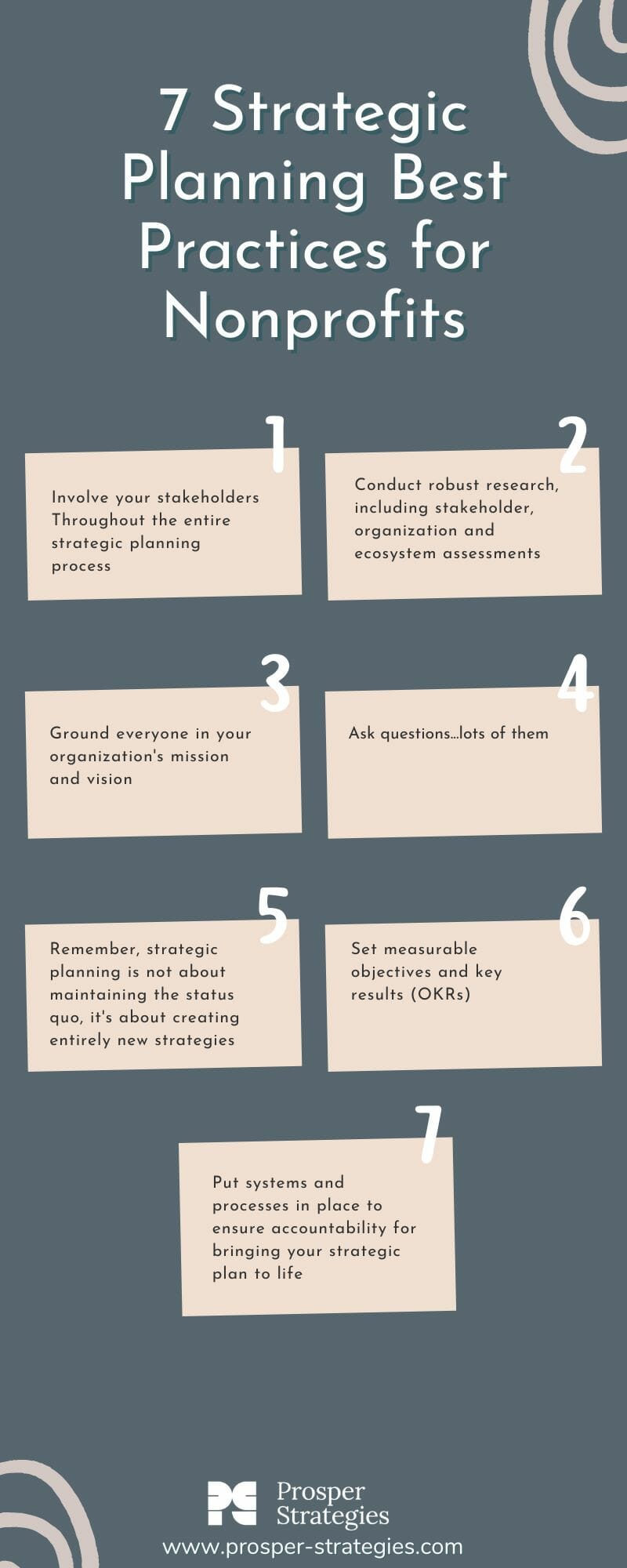
Nonprofit Strategic Planning Best Practice #1: Involve Your Stakeholders Throughout the Entire Strategic Planning Process
If you’re familiar with our Shared Power StrategyTM Philosophy, this best practice should come as no surprise. You’ll also see it in action in several of the strategic plan examples above. An effective strategic planning process starts with identifying all of the internal and external stakeholders who need to be involved in strategic planning, including your clients, program participants and anyone else who your mission exists to serve.
We suggest starting with the development of a primary planning committee. This is the group of individuals who will be stewarding your nonprofit’s strategic plan from start to finish. The primary planning committee is typically made up of leaders within your nonprofit organization. Individuals who will likely be on this committee include:
- Your executive director or CEO
- Your director of operations
- Your director of finance
- Your director of fundraising
- Your director of marketing
- Your director of programs
Additionally, we recommend identifying a board strategic planning committee, which is comprised of a select group of board members who are engaged at strategic checkpoints throughout planning to provide inputs before elements of your plan are shared with the full board. This group may vary based on the size of your board, but should include no more than 4-6 board members.
Finally, but most importantly, you should organize a stakeholder committee, made up of clients/beneficiaries, community members, donors, funders or any other individuals who impact or are impacted by your mission. When building your strategic plan timeline, you’ll want to determine when and where these groups should be involved and what role you expect them to play . We often use the DARCI model (see below) to help teams align about how important decisions will be made during strategic planning.
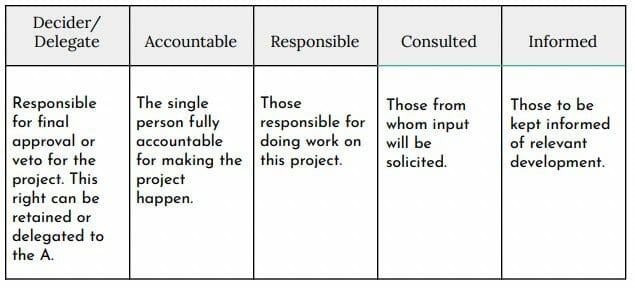
Ideally, you’ll want to involve stakeholders outside of your staff and board not just at the onset of the strategic planning process, but at key checkpoints throughout, and as you start to bring your strategic plan to life. Your organization exists to serve your stakeholders, and simply deploying a survey or conducting a few interviews just isn’t enough. If you want to make your strategic plan a success, ensure you’re truly sharing power to develop your plan with your stakeholders.
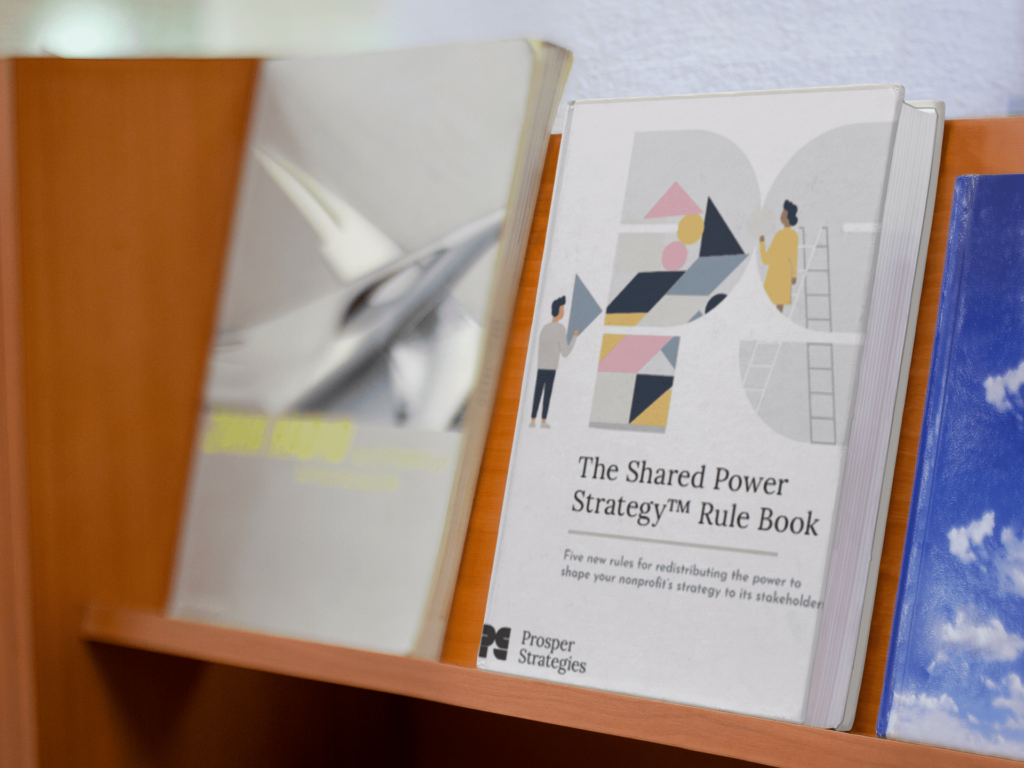
Related tools: Check out the Shared Power Strategy™ Rule Book for more about how to involve your stakeholders in strategic planning, and why you must. Then, use these Stakeholder Audit and Engagement Worksheets along with the strategic plan examples to begin mapping out your plan.
Nonprofit Strategic Planning Best Practice #2: Conduct Robust Research
The best strategic plans are grounded in deep research, not just into stakeholder perspectives, but into existing models, comparator organizations, ecosystem trends, and more. Working with your primary planning committee, you’ll want to conduct an organization assessment, where you’ll review important documents, such as past strategic plans, financials, program plans, cases for support and annual reports to better understand your organization’s current state.
Then, you should conduct an ecosystem assessment, where you analyze the business models of several comparator organizations, or nonprofits that provide similar services to those of your own. This information helps to align the strategic planning team around the same set of baseline research and ensures the team knows your current positioning among other nonprofits in your space.
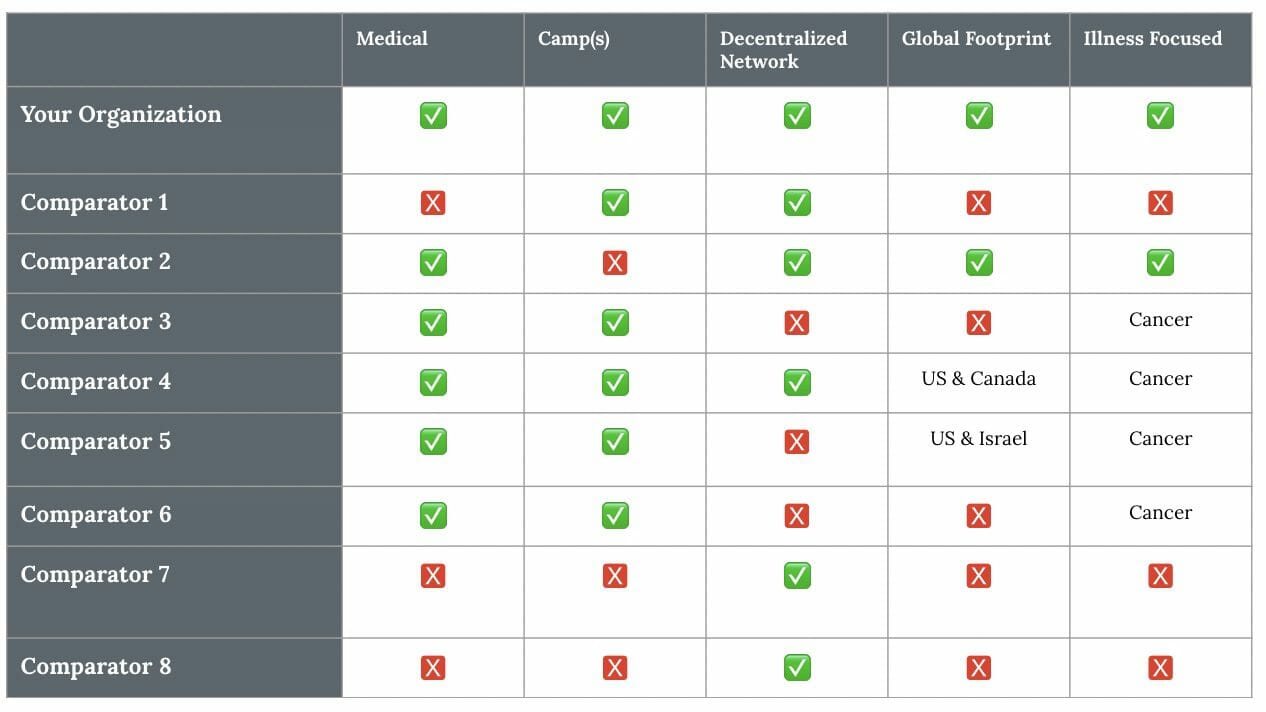
The combination of stakeholder inputs and these assessments will begin to manifest your nonprofit’s strengths, weaknesses, opportunities and threats, or the things you will likely address in the strategic planning process going forward. To ensure everyone is on the same page, summarize key “a-has” from your research as takeaways that everyone can keep top of mind as you get deeper into planning.
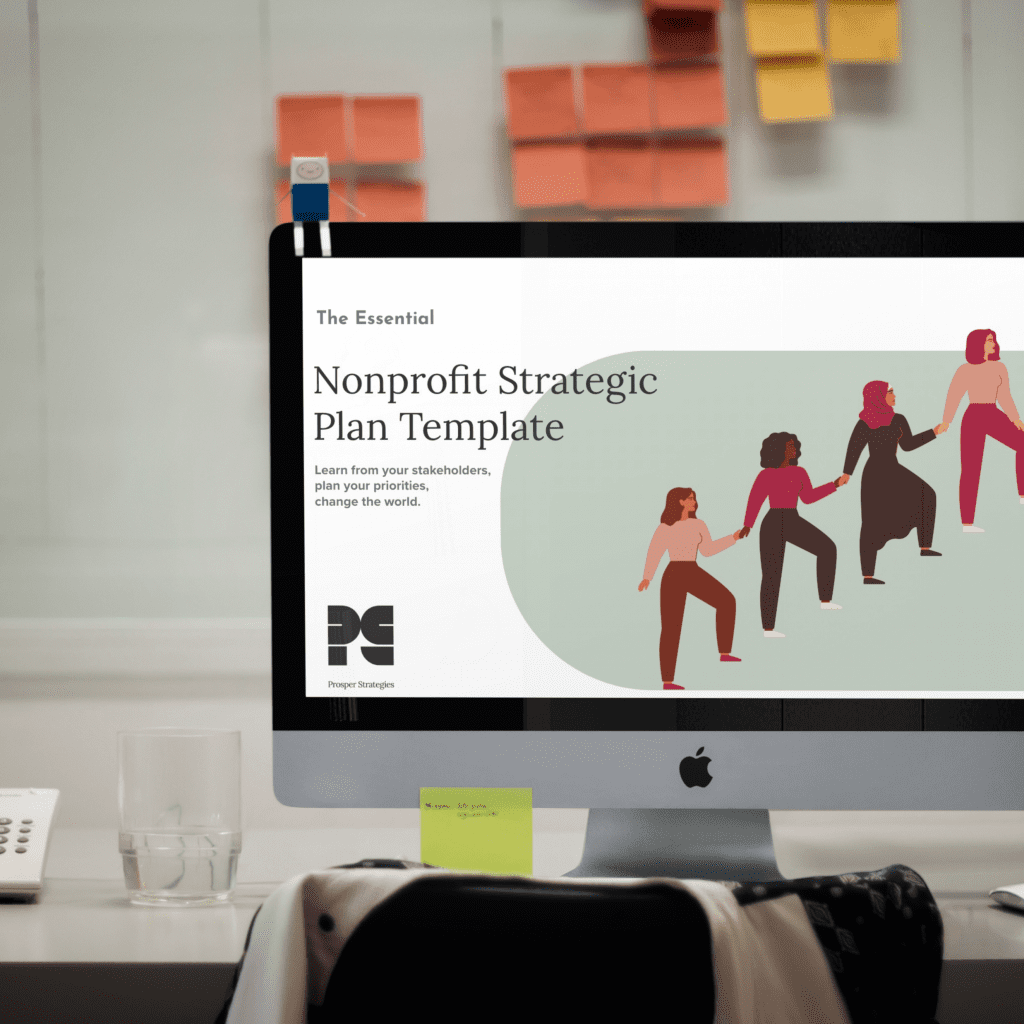
Related tool: We walk through the research process in depth in the Essential Nonprofit Strategic Planning Template.
Nonprofit Strategic Planning Best Practice #3: Ground Everyone in Your Mission and Vision
Remember, a vision statement describes the aspirational future your nonprofit is building toward and a mission statement describes the work you are doing every day to bring it to reality. Grounding each strategic planning committee in these statements is essential for successful planning. While they’re meant to stand the test of time, these statements should be re-evaluated every time you go through strategic planning to ensure that they still hold true as dynamics change. You should not take revising your mission or vision statements lightly, but you also shouldn’t move through the strategic planning process tied to old statements that no longer articulate what the world needs from you or where your organization needs to focus.

Related tool: For guidance on (re)evaluating your nonprofit’s mission and vision statements, download our 101 Guide to Mission and Vision Statements.
Strategic Planning Best Practice #4: Ask Questions
Once you have developed or reaffirmed your vision and mission statements, work with your primary planning committee to imagine the next three years and what they look like when your nonprofit meets all of its goals. We like to start this part of the process by asking the question coined by author Dan Sullivan as the “three year question”:
If we were having this discussion three years from today, and you were to look back over those three years to today, what has to have happened for you to feel happy about your progress?
While this question will increase alignment among members of the strategic planning committee, it will also raise additional questions, which we call “strategic questions”. Should we expand our geographic reach? How do we diversify revenue streams? Does our brand identity accurately represent our vision for the future? How do we attract and retain talented staff? Brainstorm as many questions together as you can regarding new opportunities, competitive challenges and business model challenges related to your three year picture. Then break these questions into thematic categories. For example:
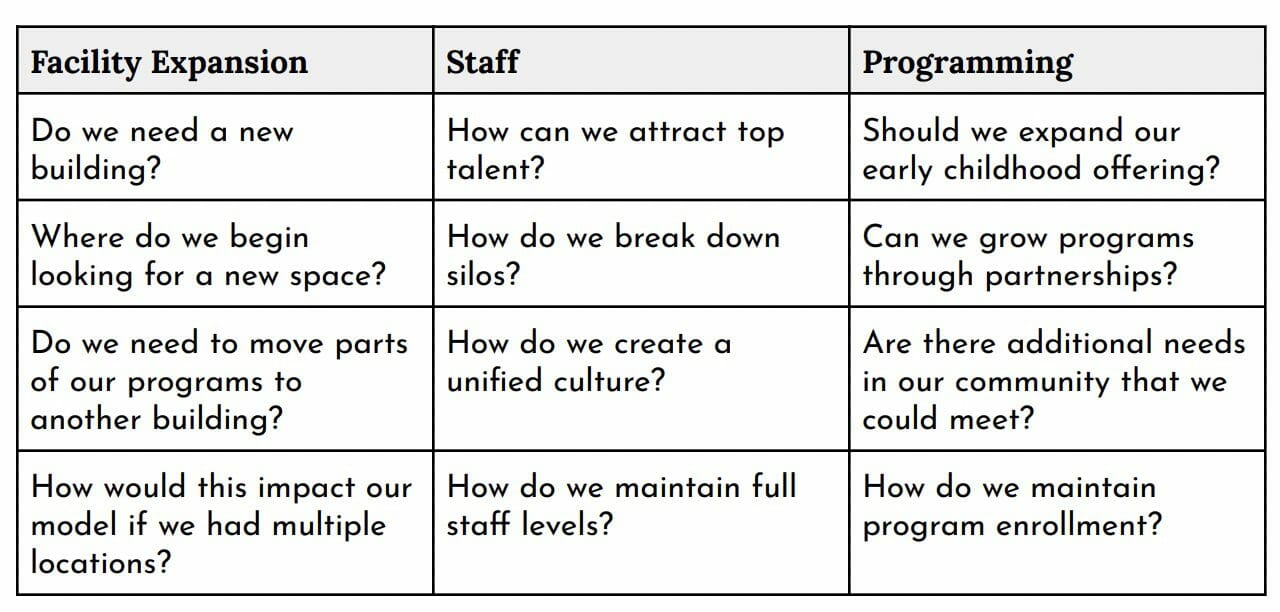
Strategic Planning Best Practice #5: Remember, Strategic Planning is Not About Maintaining the Status Quo, it’s About Creating Entirely New Strategies
Evaluate each category from your strategic question brainstorm to determine if answering these questions should be part of your day-to-day work or if it requires a new strategy, and therefore a place in your next strategic plan. If you’re having a difficult time prioritizing which categories elevate to the level of your strategic plan, consider using a tool like the Eisenhower Matrix to facilitate a discussion about urgency and importance. Then, use the thematic categories you’ve determined are top priority to articulate your 3 to 5 strategic plan pillars, or the big priorities your organization must focus on in order to advance its mission, and drive toward its vision over the next 3 years.
Pillars are expressed in broad, thematic terms. Here are a few examples from real strategic plans we’ve worked on:
- Enhance operational excellence
- Strengthen parent/family programming
- Elevate our brand and thought leadership nationally
- Scale up our proven program to serve more youth, families and communities
Nonprofit Strategic Planning Best Practice #6: Set Measurable Objectives and Key Results (OKRs)
For each of your pillars, you should create a set of 1 to 4 objectives, which are the measurable key outcomes that need to be reached to achieve each pillar. You’ll see this in action in many of the strategic plan examples above.
Sample objectives include:
- Pillar: Enhance operational excellence
- Objective: Develop employee recognition program
- Pillar: Strengthen financial position
- Objective: Diversify revenue streams
- Pillar: Elevate our brand and thought leadership
- Objective: Increase and amplify global recognition
- Pillar: Scale up our proven program to serve more youth
- Objective: Expand geographic footprint to reach more youth
Then, for each objective, you will also set 1 to 3 key results, which are the measurable indicators of whether objectives are being achieved. The most effective key results sets include a mix of output-oriented key results and outcome-oriented key results.
Related resource: What’s the difference? Learn more about output and outcome-oriented key results here.
Example output-oriented key results include:
- Pillar: Enhance operational excellence
- Objective: Develop employee recognition program
- KR: Create value-award nomination process by end of Q4 2028
- Pillar: Elevate our brand and thought leadership
- Objective: Increase and amplify global recognition
- KR: Create new brand name and visual identity by Q4 2027
Example outcome-oriented key results include:
- Pillar: Strengthen financial position
- Objective: Diversify revenue streams
- KR: Increase funding by 5% for new programming by 2030
- Pillar: Scale up our proven program to serve more youth
- Objective: Expand geographic footprint to reach more youth
- KR: Expand to 2 new geographies by 2029
Related resource: for more on Pillars and OKRs read our post: “How to Set Pillars and OKRs to Advance Your Nonprofit’s Mission“
Nonprofit Strategic Planning Best Practice #7: Put Systems and Processes in Place to Ensure Accountability for Bringing your Strategic Plan to Life
After your team feels that you have a solid set of objectives and key results in place, you’ll want to make sure that everyone is accountable to carrying out the goals you have set together. Walk through each one of your pillars, objectives and key results and assign an owner for each. Then, meet regularly for continuous evaluation of the strategic plan.

Related tool: Our nonprofit strategic plan dashboard tool makes this simple, and provides more tips on the systems and processes you need to put in place as you begin to roll out your strategic plan.
Key Takeaways for Nonprofit Strategic Planning
-
Strategic plans work best when they focus on clear priorities and outcomes, not long wish lists.
-
Real examples from other nonprofits can spark structure, but every plan must reflect your mission and stakeholders.
-
Engaging staff, board, and community results in plans that are actually implemented—not shelved.
-
Accountability structures (OKRs, dashboards, timelines) turn a plan into action.
-
Templates and frameworks can accelerate planning but should always be customized.
Is there a nonprofit strategic plan template?
If you’re still feeling overwhelmed, even with all these strategic plan examples and best practices, fear not. That’s where The Essential Nonprofit Strategic Plan Template comes in. It’s designed to help your nonprofit strategic planning team understand where your organization is today and what you need to do to increase your effectiveness and maximize your mission impact moving forward. It also give you all the worksheets and documents you need to put your strategic plan together.
With this template, we’ll guide you through the process of conducting research to inform your nonprofit strategic plan. We’ll help you:
- Articulate your nonprofit’s, mission, vision and values.
- Guide your team through the process of making important decisions about your nonprofit’s course over the next 1-3 years.
- Set clear priorities (pillars) moving forward.
- Create a plan of action for bringing your strategic plan to life — ensuring everyone on your team is accountable.
Here’s a look at what’s inside the Essential Nonprofit Strategic Plan Template.
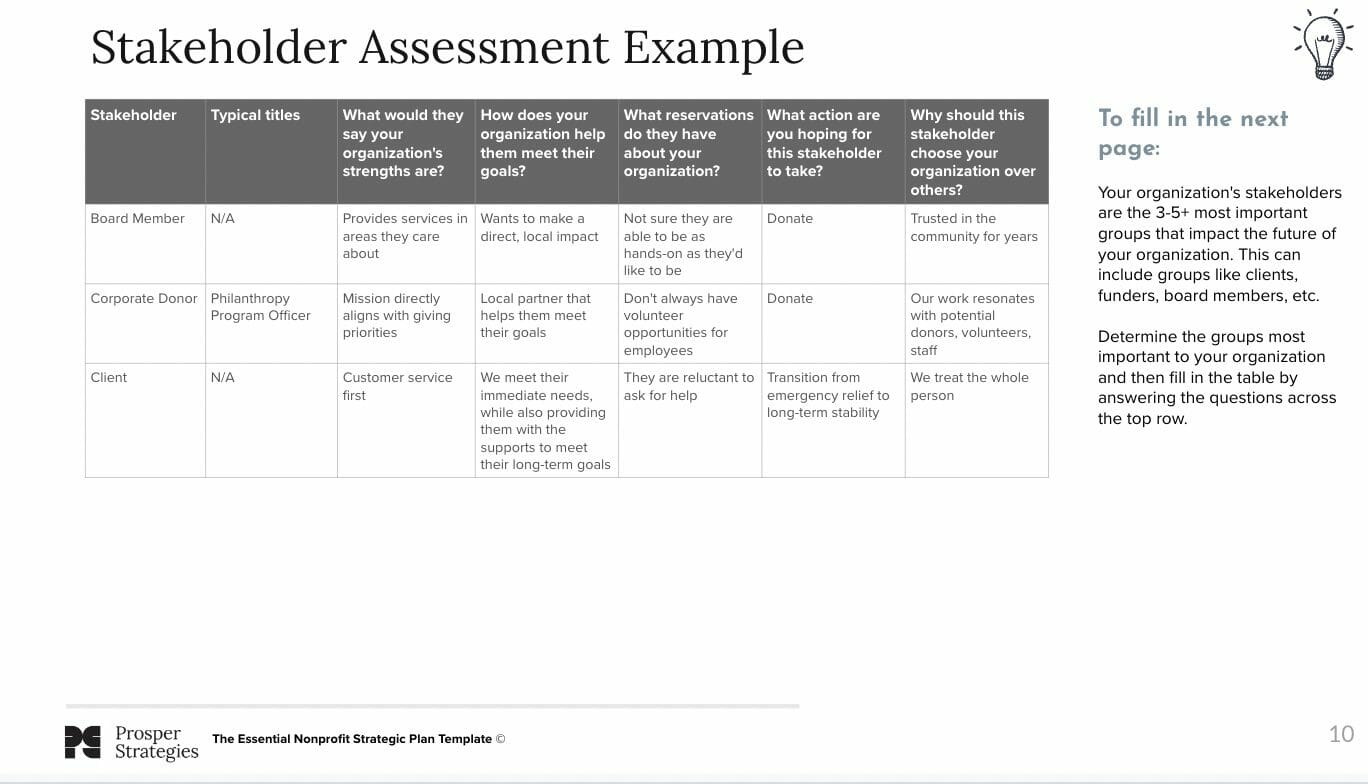
Every strategic planning process should begin with thoughtful engagement of your nonprofit’s stakeholders via a stakeholder assessment, which we walk through in the template.
This means asking folks like your program participants and beneficiaries, donors, community members, board members and staff how they currently perceive your nonprofit, what they need to hear from you, and where they think you can improve.
You’ll start by auditing your stakeholders and then choosing the best ways to engage them at the onset of your strategic planning process. Then, you’ll continue to keep your stakeholders informed and involved as you continue to shape your strategic plan. We’ll show you how.
Inside the Essential Nonprofit Strategic Plan Template: Research
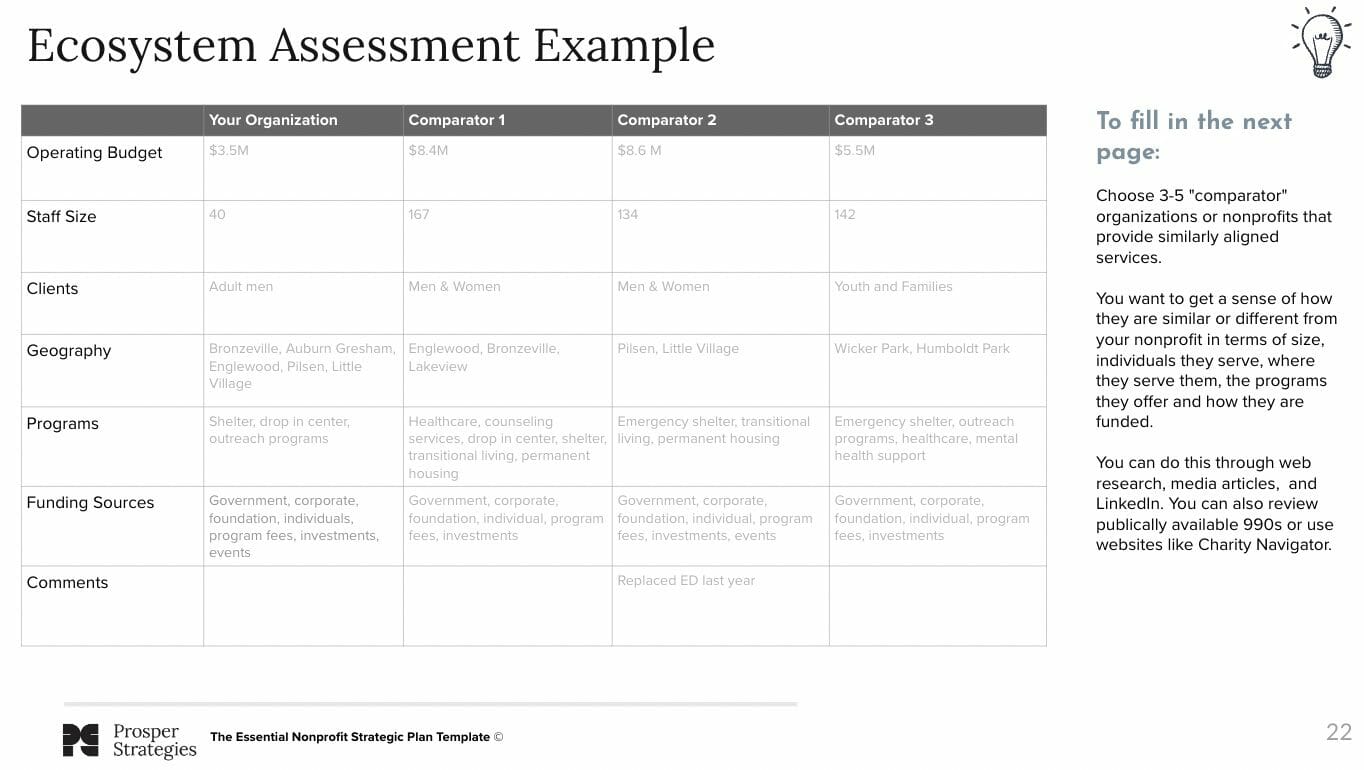
Before you put pen to paper, you need to develop a clear understanding of where your organization is today, so you can chart your course for the future. The Essential Nonprofit Strategic Plan Template provides you with all of the tools and templates you need to do just that.
You’ll conduct organization assessment, where you’ll identify whom you serve, where you serve them, the programs you offer and how you’re funded. Then, you’ll take a look at other nonprofits in your area to assess how your nonprofit is similar or different. You’ll also look generally at trends in your space.
This section of The Essential Nonprofit Strategic Plan Template ends with a SWOT, or an assessment of your organization’s strengths, weaknesses, opportunities and threats. The SWOT is a great launching pad for identifying your nonprofit’s upcoming strategic priorities.
The template is complete with many of the tools you need to conduct these assessments, but also strategic plan examples to help you successfully complete each one.
Inside the Essential Nonprofit Strategic Plan Template: Mission, Vision and Values
Within the template, you’ll find resources for creating or reevaluating your nonprofit’s mission and vision statements, which define the future your nonprofit is working to create and the work you’re doing every day to get closer to that reality.
You’ll also find ideas about how to craft your nonprofit’s values. All of these elements are fundamental to your nonprofit’s ability to make strategic decisions today and the future, so it’s worth taking the time to get them right.
Inside the Essential Nonprofit Strategic Plan Template: Strategy Exercises, Objectives and Key Results (OKRs)
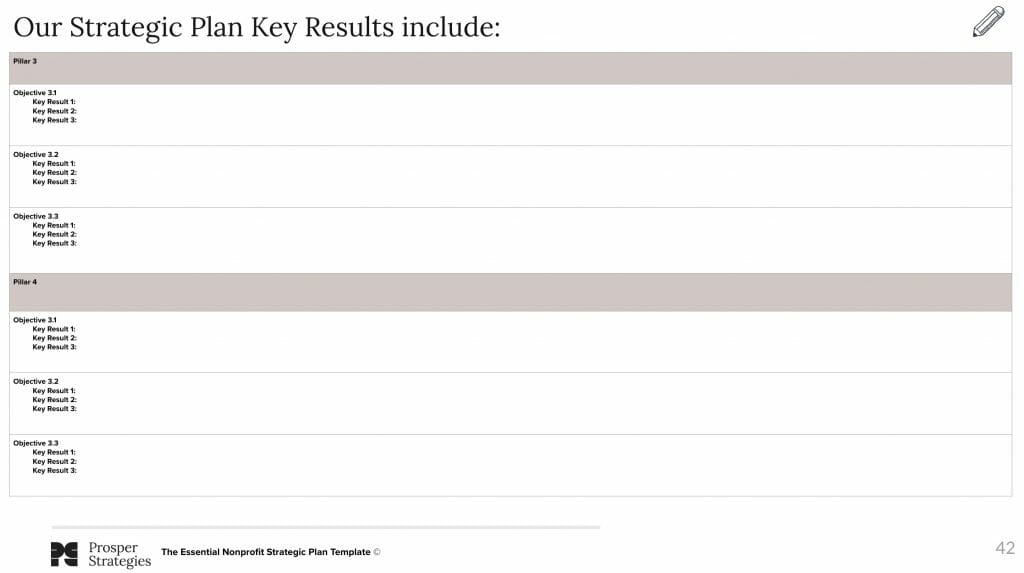
Next, we take you through several exercises to help you do some BIG thinking about your nonprofit’s future and your priorities. This is where we help you start brainstorming your strategic planning objectives by reflecting back at your organization’s SWOT analysis and working through the biggest strategic questions your organization is facing. Then, we help you narrow those questions down into categories that become your pillars, objectives and key results.
We recommend choosing no more than 3-4 organization-wide objectives for the year. Therefore, once you’ve brainstormed all of your potential objectives for your strategic plan, we help you narrow them down based on each one’s:
- Potential impact on your organization’s mission and outcomes
- Urgency to complete in the coming year
- Likelihood it can be accomplished in the coming year with your existing team and resources
- Measurability
Inside the Essential Nonprofit Strategic Plan Template: Dashboard, Meeting Cadence and Strategic Plan Document

Finally, we help you bring accountability to your nonprofit strategic plan. This is the part of the process where most organizations stop short. They have their strategic objectives, but they fail to make those objectives actionable by breaking them down with quarterly milestones.
In this section, we provide a dashboard and recommended meeting cadence so your nonprofit will begin to look week-by-week, month-by-month and quarter-by-quarter at what you need to do as a team to reach your objectives. The dashboard and meeting cadence will also help you evaluate your progress, see where you’re falling short and make adjustments on the fly. This ensures you can adopt a structured approach to achieving the objectives and key results in your strategic plan, while also maintaining agility to shift and change plans as unforeseen circumstances arise.
Inside the The Essential Nonprofit Strategic Plan Template, we’ve also included a link to a Google Doc / Word Doc strategic plan template you can begin filling in once your plan is ready if you like a more “narrative” format for your plan.

Ready to Get Started with Nonprofit Strategic Planning?
Download The Essential Nonprofit Strategic Plan Template.
Still have questions? Here are some strategic planning FAQs (and answers!)
1. What is a nonprofit strategic plan?
A nonprofit strategic plan is a written roadmap that outlines your organization’s mission, vision, priorities, and goals for the next three to five years. It defines what success looks like, identifies the key strategies and actions needed to get there, and ensures everyone—from board members to staff—works toward the same direction. A strong nonprofit strategic plan helps your organization stay focused and measure progress toward its mission.
2. Why is nonprofit strategic planning important?
Nonprofit strategic planning is essential because it turns big-picture vision into an actionable plan. Without a strategic plan, nonprofits often react to opportunities or crises rather than following a clear path. Strategic planning helps align leadership, staff, and stakeholders, prioritize limited resources, and communicate progress to funders and the community. In short, it keeps your organization proactive, not reactive.
3. How often should a nonprofit create or update its strategic plan?
Most nonprofits develop a new strategic plan every three to five years. However, your plan should be reviewed annually to track progress, update key results, and respond to changes in your environment or community needs. A good nonprofit strategic plan is a living document, not a one-time project.
4. What are the main components of a nonprofit strategic plan?
A nonprofit strategic plan typically includes:
-
Mission, vision, and values statements
-
Strategic priorities or pillars
-
Objectives and key results (OKRs)
-
Implementation timelines and milestones
-
Accountability systems and dashboards
Together, these components create a clear picture of what your organization will accomplish and how success will be measured.
5. Who should be involved in nonprofit strategic planning?
The best nonprofit strategic plans are co-created with input from diverse stakeholders. This includes staff, board members, program participants, donors, and community partners. Involving those who benefit from or influence your mission ensures the plan reflects real needs and builds shared ownership across your organization.
6. What’s the difference between a nonprofit strategic plan and an operational plan?
A nonprofit strategic plan sets the long-term direction—your goals, priorities, and desired outcomes over several years. An operational plan translates those strategies into short-term actions, assigning responsibilities, budgets, and timelines. In other words, the strategic plan defines what you’ll achieve; the operational plan defines how you’ll achieve it.
7. How can a nonprofit ensure its strategic plan is implemented effectively?
To make sure your nonprofit strategic plan leads to action, assign clear ownership for each goal, use measurable key results, and meet regularly to review progress. Tools like Prosper’s Essential Nonprofit Strategic Plan Template include dashboards and accountability systems to keep your plan active, not forgotten.
8. Can small or volunteer-run nonprofits use a strategic plan template?
Yes. Even small nonprofits or all-volunteer organizations benefit from having a clear, focused plan. Prosper’s Essential Nonprofit Strategic Plan Template scales easily for organizations of any size, helping you define priorities, engage your board, and track progress—even with limited time and resources.
9. How do I choose the right strategic plan format for my nonprofit?
The right format is one your team will actually use. Some nonprofits prefer a short, visual plan; others use a detailed written document. Reviewing real nonprofit strategic plan examples—like the 50+ listed in this guide—can help you identify a structure that fits your mission, staff culture, and audience.
10. Where can I download a free nonprofit strategic plan template?
You can download Prosper Strategies’ Essential Nonprofit Strategic Plan Template to guide your planning process. It includes stakeholder engagement worksheets, research tools, and OKR templates to help your team create a focused, actionable, and measurable strategic plan.
Want more on nonprofit strategic planning? See these related resources:



